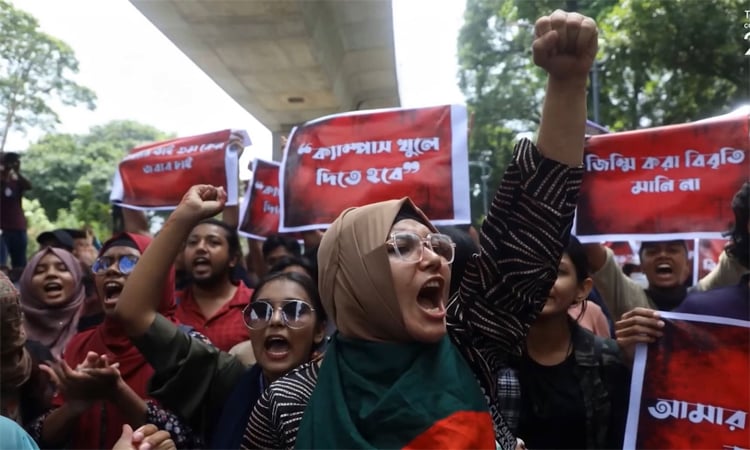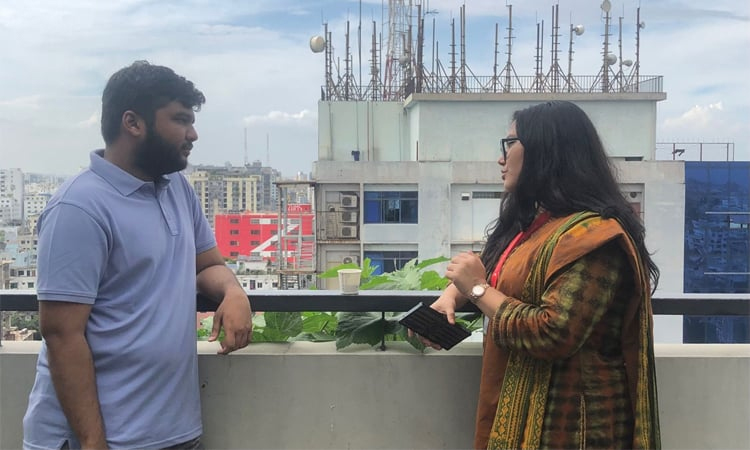News Flash

By Jubayer Ibn Kamal
DHAKA, July 7, 2025 (BSS) - Student politics has long remained dormant in Bangladesh's private universities, where political activities are hardly seen.
But we saw different pictures as students of private universities participated during the July 2024 movement as they played historical and courageous role in mobilizing the protests that eventually turned into a mass uprising.
In a powerful show of solidarity, students from private universities—despite having no direct stake in the quota reform—took to the streets in protest.
Defying police crackdowns and violent attacks by the banned Chhatra League, they played a pivotal role in sustaining the momentum of the movement. Among the frontline protesters was Sania Amin Snigdha.
A journalism student at Canadian University in Dhaka, Sania lives with her mother and younger brother following the death of her father five years ago. From the very beginning of her university life, she has been vocal against authoritarian policies and attacks on free speech by the then-Awami League government. Her participation in the quota reform protests and the broader July Uprising marked her as a leading figure among private university activists. Following the closure of Dhaka University dormitories on July 18 in an attempt to quell the protests, students from private universities declared they would continue the movement on the streets.
In an exclusive interview with BSS, Sania recounted her experiences on the streets, the night she narrowly escaped being detained, and the price she paid for her activism. She also reflected on how the uprising reshaped her life—and what her late father’s support would have meant had he been alive to see it.
BSS: It’s been almost a year since the July Uprising. As a woman and a student from a private university, do you view the movement through a different lens?
Sania Amin Snigdha: Honestly, I only see the July Uprising as a struggle for rights. I still remember how we were terrified to even speak our minds. Fundamental rights like freedom of expression simply didn’t exist then. That sense of repression enraged us young people. That anger was what led us to the streets. Back then, questions like “Who am I?” or “What is my identity?” didn’t matter at all.
As a private university student, you weren’t directly affected by the quota reform. You probably won't even pursue a government job. So what influenced you to join the movement?
Sania Amin Snigdha: As I said earlier, the way that government was sitting on the people’s chests like a dictatorship—of course that affected me too, regardless of which university I study. It felt like this was not a movement of public or private university students—it was our collective movement.
What really pushed me was when Nahid, Asif, and Sarjis bhai—the coordinators of the Anti-Discrimination Student Movement—were picked up and taken to the DB office. I was furious. In a free country, can anyone just be picked up at will? That’s when I realized: even if it’s just to demand their release, we need to raise our voices.

When the DU dorms were shut down, most people assumed the movement would fizzle out. But the very next day, private university students took to the streets. Do you remember that day?
Sania Amin Snigdha: I was one of those private university students who stunned everyone by taking to the streets on July 18. I’ll never forget that day—part terrifying, part thrilling.
It’s not like we had meticulously planned for thousands of students to flood the streets. Rather, we felt that watching silently while so many were killed, and DU students were being thrown out of their dorms, was simply not right. It was our duty to stand beside them. People often think private university students don’t care about the country. But that day, we proved otherwise.
I had arrived at campus early that morning. Since I study at Canadian University, which is next to BRAC University, we had decided to take positions in front of our respective campuses. But things escalated quickly. We saw a group of young men approaching us with locally made weapons. It didn’t take much to realize they were Chhatra League members.
Soon after Chhatra League launched their initial attack, the police started firing. We were completely scattered in the face of this combined assault. Panic spread like wildfire. I saw dozens of students lying injured in the street before my eyes. I had never seen blood in real life. But that day, I saw blood—my brothers’ and sisters’ blood.
Honestly, the fear gave rise to an even greater rage within us. And then everything turned into courage when we heard that students from BRAC and other universities were coming to rescue us.
There were intermittent gunshots. We kept ducking into alleyways and buildings, only to re-emerge when things went quiet. Suddenly, we heard loud chanting. Through the smoke of exploding cocktails, we saw thousands of students advancing from BRAC University to rescue us. Everything changed in an instant. We began to organize for resistance. Many of us stood face-to-face with the police. They had been firing all morning and were nearly out of bullets.
That day, we saw police retreating to the roof of a building and surrendering. Later, they were evacuated by helicopter. Could you describe what happened?
Sania Amin Snigdha: That’s exactly the moment I was talking about. The police had fired so many rounds at us that they ran out of bullets. Meanwhile, students from BRAC and other universities were arriving to rescue us. Empowered by that, we stood our ground. The police, fleeing our advance, entered the Canadian University campus.
Many students followed them in. After enduring a full day of police brutality, emotions were running high. Even inside the building, the police didn’t stop shooting. I heard a student from another university was killed. That triggered an explosion of fury among us.
The police eventually climbed to the rooftop of Canadian University. In anger, some students wanted to set the building on fire. While some were stopped or backed off, fires did break out in several spots—partly to counter the effects of tear gas. As the flames spread inside the university, the police on the roof surrendered with folded hands.
What happened afterward?
Sania Amin Snigdha: There’s a mosque right next to our university. Police went there and announced that they wouldn’t fire anymore and asked the students to disperse. But just a few hours earlier, we had heard that they killed at least two people by shooting. Still, we remained calm.
When the police entered Canadian University earlier that day, some of us had remained outside. Two of them were injured during the chase and counter chase. We helped those injured police officers get into an ambulance. But the country saw what reward we got for that.
Later, the police apologized and asked us to leave. But we stayed on the streets. Eventually, a helicopter landed on our rooftop and evacuated the police.
How did you participate in the movement in the days that followed?
Sania Amin Snigdha: I actually left home. To be honest, block raids were happening then. At night, they were picking up students from their homes. I still shudder at the thought of how horrific those days were.
I was very visible in the July 18 protest—lots of pictures and videos of me were circulating. I thought no one would see them since the internet was shut down. But that night, a group of plainclothes men showed up downstairs at my home. I told my mother not to open the door under any circumstance. I started screaming from the balcony, “Robbers! Robbers!” hoping to buy some time. They left soon after. The next morning, I went into hiding. Even my mother didn’t know where I was. Though we spoke on the phone, I never revealed my location—I knew the Awami League government was tapping calls.
What were you doing while in hiding?
Sania Amin Snigdha: What else? I joined the movement. I went toward Shahbagh. My feeling was—after all these killings, this regime cannot sit in power and mock us. I knew if I stayed home, my mother and younger brother could be in danger. So I chose to keep them safe. I was ready to give my life. We had nothing left to lose.
I joined other female students in Shahbagh and protested with them. We moved from place to place together. When the curfew was enforced, we would seize any two-hour break to try to stage demonstrations. Those days were terrifying—just thinking about it gives me goosebumps.
Can you share some of those experiences?
Sania Amin Snigdha: There are many of such experiences. The July days were the most horrific chapter of my life. Once, Chhatra League chased us toward the police—inside Dhaka Medical College. Even there, they beat us severely. We fled and took shelter elsewhere.
As evening fell, Dhaka turned into a ghost town—no cars, no people. Just endless gunshots and silence. One time we were stuck on the road. I stuffed fabric under my clothes to look pregnant and lay among my friends. When Chhatra League stopped us and asked, “Who are you?”, every moment felt like death was imminent. I kept thinking—my mother won’t even know I’ve died. Every afternoon, every night was filled with terror.
Tell us about August 5. When you heard the movement had succeeded, did you go home to your mother?
Sania Amin Snigdha: Yes, right after the victory rally that afternoon, I headed home. I hadn’t seen my mother in days. I remember knocking on the door at dusk. As I stepped in and hugged her, she wept uncontrollably. It felt like I had returned with a new life.
You mentioned your father had passed away…You became deeply involved in a major uprising. If your father were still alive, what do you think would’ve happened?
Sania Amin Snigdha: After the uprising, I joined NCP to pursue politics for justice. My father always told me—“Even if no one protests, you must.” He was associated with BNP politics and dreamed of seeing the fall of dictatorship. He didn’t live to see it, but the dictator he longed to see fall—his daughter helped bring dictator down.
I know that if my father were alive, he would’ve stood by me. Maybe during the July Uprising, I would be shouting slogans—and my father would be raising his voice beside me.